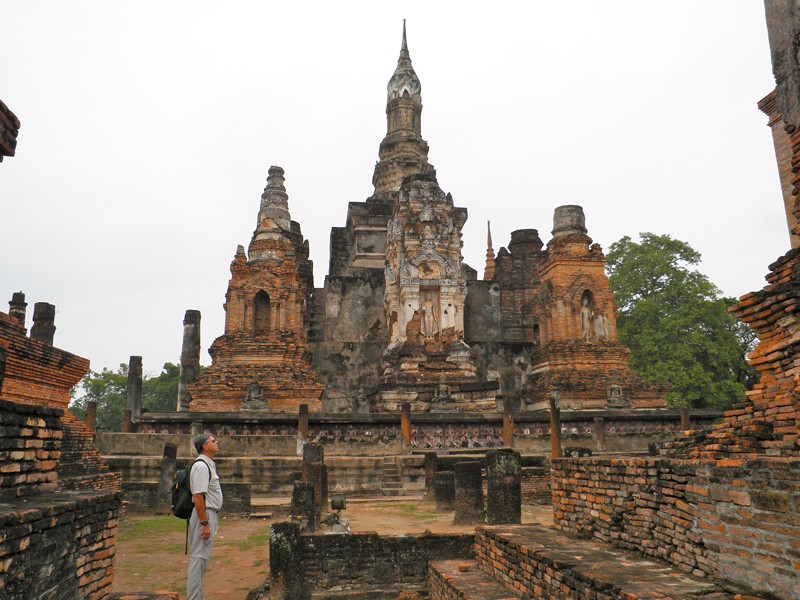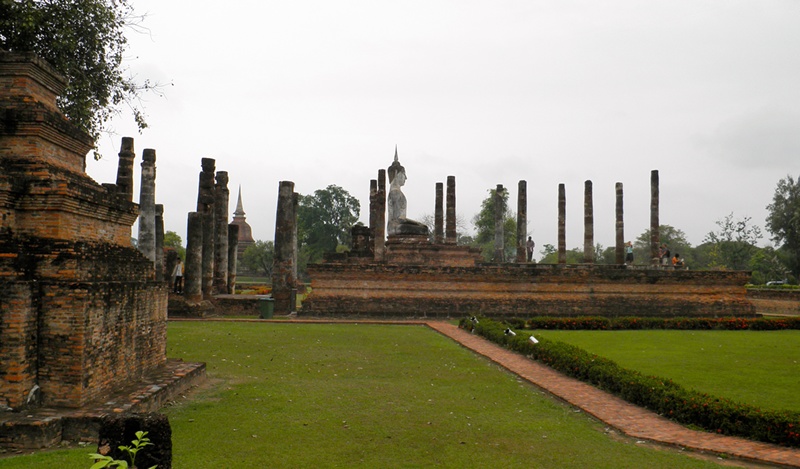Ancient History - Sukhothai, Thailand

Harmonie
Don and Anne Myers
Fri 22 Apr 2011 14:26
|
17:00.659N 99:42.859E
March 28, 2011 - March 30, 2011
Sukhothai lies about 120 miles south of Chiang Mai, and is
generally regarded as the first capital of Siam (technically that's not
completely correct, but it's easier to remember this way). Built in the
mid-13th century, Sukhothai flourished as the Siam (what is now mostly Thailand)
capital. The Lonely Planet states this period of time is "viewed as the
'golden age' of Thai civilization - the religious art and architecture of the
era are considered to be the most classic of Thai styles." The capital
city of the 'golden age' is now in ruins and nicely managed as
a World Heritage Site. The small city of New Sukhothai exists
about 6 miles east of Old Sukhothai. New Sukhothai has nothing of the
splendor of the ancient city, but its extremely low-key atmosphere was
a nice change from Chiang Mai. This is a place relatively few
tourists visit as it is a bit out of the way from the usual route, and
aside from the World Heritage Site (which is excellent as you'll see) there is
not much else to see or do here.
To get to Sukhothai from Chiang Mai we took a
bus. When we booked the bus tickets in Chiang Mai, we had visions of
sitting on a hard bench in the heat with our luggage in our laps and
chickens squawking all around. Steeling ourselves for the worst
(we kept telling ourselves that such a bus ride would be 'an adventure!',
which is what we always say when we are about to do something
extremely 'native' or offbeat), we waited for the bus to arrive at
the Chiang Mai station. What rolled up was a perfectly modern,
air-conditioned coach with comfy, reclining seats. Just like home, only
cleaner - and all for the low, low price of $7 each. Four hours or so
later we arrived in New Sukhothai where we were immediately accosted (in a
gentle, Thai way) by a woman who helped us book our bus tickets to Bangkok, and
then guided us to a tuk-tuk for transport to our hotel. It was not the
cheapest tuk-tuk ride we've ever had (certainly there was a commission paid to
the helpful woman), but since nothing in Thailand approaches the costs of home
(except for the taxis and wine in Phuket), we weren't bothered.
Below are pictures of our stay in Sukhothai.
 This is our Sukhothai hotel. Called the Ruean Thai (Thai
house), it was built to resemble a Thai temple, and is filled with antiques and
artifacts from the surrounding area. Owned by a very accommodating
Japanese couple, the place is definitely a labor of love. Since there were
no restaurants close by, we had dinner in the tiny hotel restaurant every night
with a handful of other guests. The Thai food was very good, but the
highlight for us was the ice cream. We don't get it very often, not so
much because it's not available, more that it'll melt before we can
transport it back to the boat. Such are the hardships of our life
in steamy Phuket. Speaking of hardships, during our stay at this
hotel, Don had a 90-minute Thai massage (for $10). If you aren't familiar
with the Thai massage style, I think the best way we've heard it
described is 'yoga for lazy people'. Don said his tiny masseuse used every
part of her body to stretch and manipulate every part of his. It could
almost be classified as a full contact sport.
 Wat Mahathat (Mahathat Temple). Or what's left of it
anyway. Actually, it's pretty amazing to think this temple was originally
built in the 13th century. It's hard to get a handle on the age of
everything in Thailand given the short history we're used to of buildings
in the US. This was the largest and most important of the dozens of
temples built in and around Old Sukhothai, and today is the largest and most
intact ruin. We were amazed at how accessible all the ruins are.
This is a World Heritage Site, and tourists are allowed to wander at will (which
we loved). The only thing we were discouraged from doing was climbing up
any of the remaining walls or climbing on the Buddhas (hopefully no one would
climb on a Buddha). As you can see, we had the place pretty much to
ourselves. It was so peaceful. The sky was cloudy with a fine mist
falling most of the day and we were just happy to feel cool, even a little
chilly, while surrounded by all this history.
 Originally, the entire city of Sukhothai was surrounded by a
moat. The same was true for most of the temples inside the city
walls. In the case of the temples, this was done not so
much for security, but more to isolate the structures and keep them 'pure' via
the barrier of water. The bridges, like this one, have been
added. On the other side of the bridge, you can see the temple
pillars that once supported a roof. The Buddha is in very good shape,
and like all major Buddha images, faces east.
 Buddhists still pay their respects at the Sukhothai temples.
 Behind the Buddha and slightly to the left is one of 198 chedi
in the area. The typically bell-shaped or lotus flower bud-shaped
structures were built to house highly significant religious relics. Note
the shiny gold fingernails on Buddha's right hand. At one point, all the
Buddhas of Sukhothai were probably covered in gold paint or gold leaf more like
the current glitz of Chiang Mai and Bangkok temples. It was really
interesting to see the remains of Buddhist temples minus all the gold. In
some ways, it could be said the open air, back-to-nature,
stripped-down-to-its-core atmosphere of Sukhothai's temples reveals the
truer nature of Buddhism than all the glam and gold of Chiang Mai's temples
or Bangkok's Royal Palace (based on the tiny bit we know about
Buddhism, anyway).
 Doesn't this Buddha look incredibly righteous and stately
sitting so ramrod straight and staring off to the east?
 Don looks like such a small person in the presence of Buddha,
doesn't he?
 This is what we thought we would be riding in from
Chiang Mai to Sukhothai. Instead, this is what we rode in from New
Sukhothai to Old Sukhothai and back. Not a bad way to travel,
really. There were no chickens and we didn't have to sit on the roof, but
we did ride with a few locals, who didn't seem to mind our presence. Top
speed was about 30 mph and the driver was happy to pick up or drop off
passengers at any point along the way. The mostly open sides gave us a
good view of the 15 or so teak furniture stores and wood-working shops
we passed between old and new Sukhothai. Although teak logging is no
longer allowed in Thailand, the teak must be coming from somewhere
(Burma?).
 Here's a glimpse of the less than pretty downtown area of New
Sukhothai (quite a contrast from serene Old Sukhothai). These traffic cop
stations topped with helmets are everywhere in Thailand cities. I just
love the giant helmet. It reminds me of the giant green-lipped mussels on
top of a restaurant in New Zealand and the Big Banana in Australia.
While we were off gawking at ancient ruins in Sukhothai, John
and Sue were battling a major rain storm in Phuket. Torrential rains and
high winds were forecast, so John called to ask if Don thought the circus tent
should come down as a precaution. The circus tent is a large sun cover we
put up when in very hot and sunny marinas. It's great for protection from
the sun, but in a big wind it could easily turn into a
parachute. Don agreed the tent should come down, so while we lazed in our
Sukhothai hotel room watching the international news, poor John stripped down to
his boxers and braved the torrential rain for over an hour while he wrestled
with dismantling the circus tent in the dark. Sometimes it's good to
have guests on board when we aren't there. : )
Next up: Bangkok.
Anne |